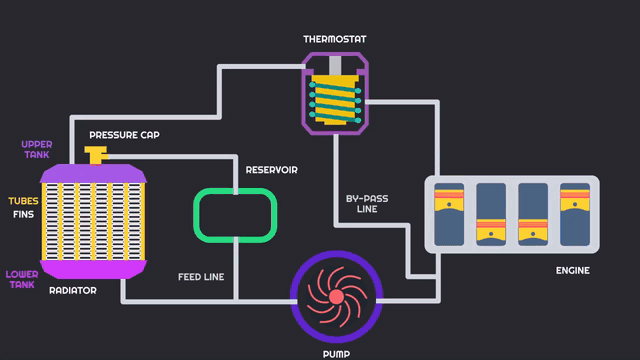What is Radiator?
The radiator is a heat exchanger device. It helps in cooling and heating by transferring thermal energy from one means to another. It basically cools the internal combustion engines of automobiles but also supports in motorcycles, railway locomotives, stationary engines, and so on. In buildings, radiator is used as a heater.Types of radiatorThe radiator has high thermal conductivity and due to this reason, copper and brass are materials of radiators. In some cases, plastic and aluminum are also used to make radiators.
Parts of Radiator
There are five main parts of radiator, they are-a) Pipes b) Fins c) Valve d) Coolant e) Tubes
What are the types of Radiator?
Depending on the direction of the water flow through radiators they are usually classified into two types. They are named as:Tubular type: Tubular type core has two tanks, one in the top and the other in the bottom. Water flows through many tubes mounted in a parallel arrangement and those tubes are remain joined with the tanks. To increase heat transfer quality fins are placed around the tubes. Air passes from the fins and soaks up the heat from the flowing water.
Facts about the tubular type core are
- All the tubes remain busy to pass water.
- If one passage gets blocked then the whole tube lost the cooling upshot.
- Uses: These radiators are mostly used in motor vehicles and airplanes.
Facts of the cellular type of core are
- From the front side, the cells look like hexagonal shape. Generally because of this type of distinct look cellular type core is named as honeycomb radiator too.
- In this core radiator if one tube gets blocked then only a small portion lost the cooling upshot.
What is the working principle of Radiator?
The radiator has two tanks, one is connected to the water outlet and the other is connected to the jacket inlet with the help of water pump. There is also a core which helps to cool the water. Aluminum radiators are popular for modern cars.
The working procedure of a radiator is not so complicated. A fan joined with the radiator cools down the water when it enters the radiator via the inlet path. Cool water then passes via the series of tubes from the inlet to the engine.
In aluminum radiators, the aluminum fins that are attached with the tubes are named tabulators. Hot coolant from engine fills the tubes and the fan helps coolant coat absorbs that heat. Again the blowing air also cools the aluminum coat. If the passing fluids flow smoothly and touch the tubes directly then it cools down directly too. Finally, the fluids go to the cooler and then to the engine again.
Cooling process in cars’ engine
The procedure is actually the same. When we start a car the temperature of the engine goes to high. The liquids take the heat from the engine and cools down again with the help of radiator.The liquids become cooler when the cars’ exterior provides air through the vent. When the coolant gets the exact temperature it returns back to the engine.
Necessary Maintenance of Radiator Types of radiator
- Internal pollutants can block or pollute tubes and fins of radiators, so, they should be washed regularly.
- Outer surfaces also should be cleaned of bugs.
- Filtered water and specialty coolant are essential for this cooling system.
- To use a radiator for a long time routine testing of pressure and core flushing is needed.
- Radiator with faulty fins and tubes must be replaced or repair properly because it can cause leaking or fracture as well.



Post a Comment